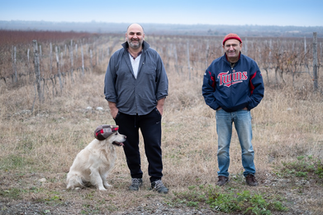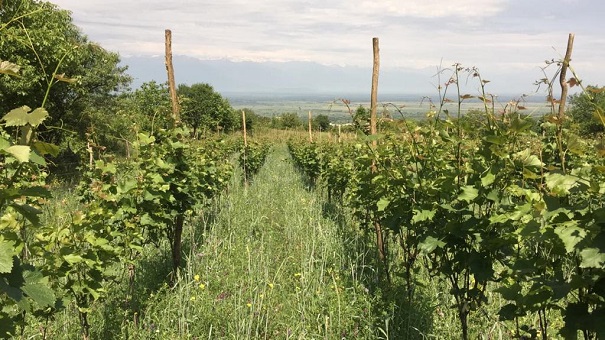Georgia. The stronghold where Neolithic viticulture survived.
- Miguel Crunia

- Nov 19, 2021
- 9 min read
Updated: Feb 18, 2022
For ages, Georgians were growing vines organically. It was an ancestral practice, something natural to them, they had it in their blood. It is for this reason that they have never thought about canonizing that knowledge into a manual that could be passed from one generation to the following. Winemaking was something inherent to Georgians, nobody needed a manual. However, they've been cut off that knowledge.
During the Soviet era, all the vineyards and cellars in the country were seized by the State, leaving just a half-hectare for the personal use of the vinegrowers, with the only condition that the rest of their harvest had to be destined to those companies ruled by the central power.
The Soviets brought modern techniques of vinification that could help them to produce larger yields doing as little work as possible. This modernization could seem a good thing at first glance. However, let me put this in other words: When wine production grows considerably, it means that quantity is given more priority than quality, leading to many of the native varieties (and all their richness) being neglected in favor of the planting of other varieties that help to create wines with a homogeneous flavor. The singular vineyards were stopped being vinified separately to mix them all in the same stainless steel tanks. In this way, varieties such as Saperavi and Rkatsiteli, capable of producing large crops and resisting extreme conditions of both cold and heat, gradually prevailed and ended, little by little, with many of the indigenous Georgian varieties.
Only one type of wine was produced back then, which was "bad wine." It is anecdotal to highlight that, in times of the USSR, it was said that whoever wanted to drink good wine, they need to drink the wine of the peasants and vine growers.
It was precisely the fact that each family was allowed to keep half a hectare to produce homemade wine, which allowed the viticultural wealth of the country not to be depleted since the wine for its own consumption respected ancestral traditions and preserved more than 500 autochthonous varieties that we have today.
It was not until the Russian embargo on Georgian wines in 2006 that there was a change in the mindset of the local producers. Those winemakers who left Soviet methods behind and championed the ancient ways of producing wines were the ones who captured the attention of the rest of the world. A world that was suddenly full of wine lovers who were beginning to look for real wines, emphasizing the principles of viticulture that were respectful of both tradition and the practices carried out in the vineyard and in the winery.
The focus of attention would soon be on those small winemakers who made wine in Qvevri. Qvevri is key in Georgian winemaking, sort of a simple clay vessel, essentially made of earth, and then placed underground containing the wine to be.
Georgians have quite a spiritual and mythical approach to winemaking. For them, the vineyard draws energy from the sun and transports it straight to the grape, but then, not being 100% satisfied with the taste of the grape itself, they squeeze its juice and return it back to the earth. They believe that the product isn't complete so they ferment it and let it age in Mother Earth. When they opened the Qvevri, if the wine tasted good, then the winemaker wasn't responsible for it as they believe that there is a greater power that is responsible for the final quality of the dormant wine, simply because once the Qvevri is sealed and buried, the winemaker cannot monitor the evolution until the opening of the vessel.
This is the same process developed by Georgians 8000 years ago. A method not at all interventionist, where fermentation is not controlled (burying the amphora deep in the ground is an excellent way to moderate extremes of heat and cold), and where natural yeasts are left to do their job. These fermentations can last up to 3 months! Although the wine contained in several Qvevri could come from the same varietal planted in the same vineyard, each of the amphorae contains a living organism that has its own needs, so the winemaker needs to act accordingly, since the fermented wine in one of the vessels may need more punching-downs, other none, etc.
The winemakers know that fermentation is completed once all the pomace (skins, seeds, and stems) floating at the top of the wine, sinks to the bottom. It is then that the Qvevri is sealed and the wine is left to age. These solids are left to macerate in the wine for several months before removing them. Traditionally, the Qvevris were opened in springtime for home consumption, making the parallel between the Qvevri and the time a baby spends in the womb.
There are a couple of surprising factors when it comes to tasting the wines made with this ancestral method: The first is the low reductive character of the wines and, the second, that they do not have an oxidative profile at all. How can this be achieved in wines where the intervention is minimal?
Leaving the wine to rest on all that pomace and its own lees (dead yeast) means that the tannins from the skins and stems suffice as natural stabilizers. Also, the mono-proteins released from the lees act as natural antibiotics for the wine, as well as letting the wines spontaneously undergo malolactic fermentation is a key element in the stabilization process.
Regarding reductive character in the wines, it is obvious that the longer you leave the wine to mature on its lees without doing any battonage, the higher the risk of reductive odors (flint, flatulence) developing. However, all of the pomace is collected at the Qvevri's conical bottom, minimizing contact with the rest of the wine, thus preventing the development of reductiveness. Like oak, clay is porous, so it does allow for some oxygen giving the wine a deep and rich texture, but like steel, it’s a neutral material that won’t impart any additional flavors.
Last but not least, it's worth highlighting that the wines made without applying any dosage of sulfur dioxide are more likely to be exposed to all kinds of micro-bacterial activity, volatile acidity, and Brettanomyces. Good hygiene is vital to prevent infections and to ensure that, Qvevris must be scrupulously scrubbed after every vintage. Truth be told, cleaning the Qvevri is a daunting task, both in time and in the effort it takes to deal with it. Since the winemaker must first scoop out all the solids from the bottom, to then jump inside to scrub the walls using a brush made of layers of cherry bark. Once scrubbed, the Qvevri is washed with an alkaline solution and rinsed several times until properly cleaned. Some winemakers even use resinous propolis or beeswax to cover the Qvevri's inner walls due to its antiseptic properties.
Bizarrely, the cleanliness of the Qvevri is what older generations of local winemakers care about most, as they are seeing more and more young people vinifying in wine barrels and cementing the Qvevri of their ancestors.
The production of Georgian wines vinified in Qvevri only represents barely 3% of the total wine made in Georgia. The interest in this type of artisanal wine increases day by day, but, due to the small size of these wineries, they barely have the capacity to supply half of the existing demand. Let's remember that a man does not have enough strength and time in their lives to deal with many Qvevri, therefore the productions are limited as large yields are not even considered.
All this is what we were able to share during our tasting last Sunday. But not everything was oratory, we also discovered the work of 3 incredible artisanal wineries:
1) Marani Casreli: This story started back in 2015 when 5 friends (2 of them with medical background) joined their efforts together to revive their winemaking traditions, thus purchasing a childhood dream. Casreli is a small-scale winery, aka Marani. It is located in the main winemaking region of Georgia: Kakheti, on the right bank of the Alazani River. Two out of five founders, Mikheil (Misha) Dolidze and Vazha Kasrelishvili are personally involved in the winery serving as Casreli’s winemakers and managing vineyards together with the local employees.
They grow their vines organically, applying minimum interventionist techniques within the winery. They don't buy grapes from other growers, vinifying only what they grow, with a clear goal in mind: the revitalisation of ancient and forgotten Georgian endemic grape varieties.
2) Lagvinari: Lagvinari is a small winery located in Kakheti, founded by Eko Glonti, a doctor who worked as a geologist. Eko is committed to using sustainable farming methods and ancient winemaking techniques to preserve Georgia’s rich viticultural heritage. He grows his own indigenous grape varieties, as well as works closely with artisan vinegrowers in both eastern and western Georgia, due to his constant interest in understanding how the Georgian varietals perform in different microclimates and soils.
Eko founded Lagvinari in 2010 because of his devoted passion for pure and honest winemaking. Lagvinari produces all of its wines in Qvevri, favoring lengthy periods of skin maceration because, for him, all the benefits and all the goodness of his wines are concentrated in the skins of the grapes. At the tasting, we discovered his outstanding, limited production wines made from indigenous grapes in the Imereti region.
3) Papari Valley: Nukri Kurdadze knows the big side of the wine business since he had a successful career representing Pernod Ricard's brands in Russia. On retirement, he followed his dream of establishing an organic vineyard in the prized heart of the Kakheti region. His winery is named after the valley in which it sits. Papari means "horse mane" in Georgian, and the nestling hills ripple around his vineyards.
Nukri developed a terraced "marani" (cellar), in which the wine is transferred between Qvevri by gravity flow, without mechanical pumping. His wines are produced according to the traditional Kakheti wine-making method, with natural yeast fermentation and ageing in Qvevri. The low-yielding organic vineyards and the low intervention winemaking give wines of arresting depth, purity, and vitality.
Wines showcased at the tasting:
Casreli, Chitistvala 2019
A blend of Chitistvala 50%, Kisi 30% and Rkatsiteli 20%. Chitistvala ("bird's eye" is its meaning in Georgian because of the small round shape of the berry) is a rare Kakheti variety with charming tropical fruit notes. Spends 7 months in Qvevri with skins and stems. A bright wine, not at all overweighted by long maceration, with slightly biting tannins.
2. Lagvinari, Tsitska 2019
Made with an ancient variety from the Imereti region called Tsitska. Mesmerizing amber colour, the deeper of the 3 skin contact whites we poured. It spent 12 months in qvevri, 3 months of which in contact with its skins. An ultimate gastronomic wine! Naturally high in acidity, it's very well balanced with a wide and weighty mouthfeel full of deep flavors: quinces, ripe pears, ripe mirabelle plums, jasmine, honeysuckle, roasted nuts... A serious contender with the potential to age way longer.
3. Papari Valley, Rkatsiteli Qvevri 3 Terraces 2019
The journey for this particular Rkatsiteli took 8 months through the winery’s terraced Qvevri system. Its last leg was spent ageing on the third terrace in Qvevri number 18. The wine has a light amber appearance and is wonderfully refreshing. Super fruit-driven (plums, fresh quinces, apricots) and very floral (chamomile and green tea). Very drinkable right now, even though it can age for 5 more years without problems.
4. Papari Valley, Rosé 2019
Rkatsiteli with 2% of the Saperavi skins and juice. Some kind of experiment from Nukri as Rosé is not a traditional Georgian style. Also fermented in Qvevri. A visual and olfactory impression of a light, unpretentious rosé, but its structured mouth says completely the opposite, very delicate tannins and warming spicy hints.
5. Lagvinari, Aladasturi 2019
100% Aladasturi grapes are sourced from the Imereti region. This red wine spends 8 months in Qvevri, but only 3 of those are in contact with the skins. Aladasturi is a varietal that will surprise you for its finesse. A pale appearance leads to the discovery of a subtle wine filled with aromas like pomegranate, cranberries, raspberries, bay leaves, sage... Linear and with great depth. Somehow a bit pinotesque in certain aspects. Drink now or hold another 5 years.
6. Casreli, Saperavi 2019
100% Saperavi. Two weeks of skin maceration in Qvevri without stems indicates that the winemakers are aiming for a glou-glou style of Saperavi. Crunchy dark fruits and berries dominate an expressive nose, but some mineral and herbaceous notes are just adding extra liveliness to the wine. Very joyful.
7. Papari Valley, Saperavi 2019
A red wine that it's very truthful to what Georgian tradition dictates. 100% Saperavi that has matured in a Qvevri for 10 months, 6 of which in contact with the skins. The color of the wine is impressively opaque (dark as night), becoming a powerful, full-throttle, one of the bigger beasts we've ever uncorked. At 18% ABV, this wine is unusually high in alcohol. Science attributes this anomaly to an extremely rare yeast (Saccharomyces Oviformis) that grows in Papari Valley’s vineyard, and it can have an alcohol tolerance of between 16% and 21%. Saperavi is a grape that naturally retains acidity very well, and it's that backbone which dresses this wine with elegance. It does need time in the decanter, but once is tamed it expresses itself with aromas of brambles, dried fruits (cherries and plums), bitter chocolate, menthol-like notes... Quite chewy and warm. Super interesting to be tried.
Miguel Crunia
Director at Fìon
info@fionwines.co.uk


























































Comments